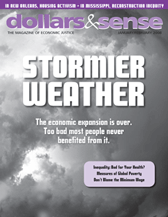Signed, Sealed, Delivered: It's a Recession
This is a web-only article is from Dollars & Sense: The Magazine of Economic Justice available at http://www.dollarsandsense.org

This is a web-only article.
Subscribe Now
at a 30% discount.
No ifs ands or buts about it, the U.S. economy is in a recession. In February the economy lost 63,000 jobs, after losing 22,000 jobs the month before. A recession has never failed to follow two consecutive months of jobs loss. And not just construction jobs were lost—manufacturing and retail jobs disappeared as well.
Investment houses—Goldman Sachs, JPMorgan Chase, Lehman Brothers, and Morgan Stanley—and Warren Buffet, the sage of Omaha and the world's most successful investor, have already declared the economy in a recession.
When the Business Cycle Dating Committee of the National Bureau of Economic Research (NBER), the private research organization designated by the Commerce Department as the nation's arbiter of the business cycle, meets this summer, they too will undoubtedly find that a recession began either in the last months of 2007 or the beginning of 2008. By that time the economy would have contracted for two straight quarters, fulfilling the shorthand definition of a recession. Still, the NBER Dating Committee will examine a wide variety of data and ascertain that there has been "significant decline in economic activity spread across the economy, lasting more than a few months"—their official definition of a recession.
The mortgage crisis continues to be the epicenter of the tremors spreading across the economy. A record high 7.9% of all loans are past due or in foreclosure. In addition, housing prices continue to drop, down 8.9% in the fourth quarter of 2007 from a year earlier, the largest drop in the 20 years of data collected by the S&P/Case-Shiller national home-price index.
Falling housing prices have left more and more borrowers with houses worth less than their mortgage. A Goldman Sachs/Morgan Stanley report projects that if home prices fall 15%, as they expect, some 21% or borrowers, or 10.5 million households, will be stuck with negative equity.
It is not just homeowners who are under water. The Fed as well is unable to right the insolvency problems of the economy. Despite the Fed having cut short-term interest rates by 2.25 percentage points, long-term interest rates remain stubbornly high. With mortgage companies out to recoup their losses and reluctant to lend, and few willing to buy the mortgage or other long-term securities—including banks reluctant to lend even to other banks—the Fed seems to have little hope of getting the economy going.
On top of that, inflation rates are picking up, with the price of oil at record levels, and food prices and the price of imports rising quickly. In January alone the price of imported goods from China increased 0.8% as the value of the dollar fell.
Hard times are upon us. Debt-deflation threatens not just the value of homes but other assets as well. Inflation drives up the prices of household staples. Job losses mount. And Fed policy has proven ineffectual.
Now is surely the time to bring the speculative economy under control, to put people to work at green jobs, and to remedy the lack of affordable housing through a massive building program that would free low-income families from the grip of predatory lenders.
